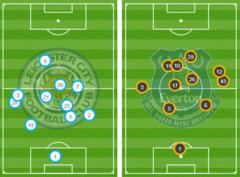Turkish-born artist Guney Soykan grew up in a home where politics and news were always present. His project Face of a Nation is a visual reflection on the volatile political situation of his native country and on the global representations of power.
Soykan creates portraits of diferent nations based on images of their leaders of the last 50 years. He used Google to find the most iconic portraits, he then splices them up and puts them together to create a composite portrait of countries like Turkey, US or North Korea.
The result are striking images that raise questions on gender, race and representations in power.
What’s the process behind your project?
The starting point for every image was curiosity: is there a story hidden in the face of that nation?
With this project I was trying to explore how different nations approach their leaders and democracy. So I’m interested in seeing different stories, unusual rhythms in the leadership timeline of the countries. That’s why I tried not only to pick the nations on the spotlight, but also the nations that are very different when it comes to view of leadership.
I tried to use the official portraits in most cases but that wasn’t always possible. The internet was my main data source for this project so when I didn’t have access to the official photo, I tried to pick the most common photo of the leader. I believe this gives a new perspective to the project, namely the way that leaders of the nations are represented in today’s world.
What was the motivation to create this project?
My father is a local politician, so I grew up in an apartment in which the news programs were always on. This made me build an interest towards politics. Seeing the strategy and communication levels in it grew my awareness even more over the years.
So when I came up with this idea, I was curious to see how the faces are going to look like. I wondered if the portraits will tell stories of the nations.
Have the changes in Turkey’s democracy been part of that preoccupation about the topic? If so, how?
The starting point of the idea was the November 1, 2015 elections in Turkey. The results were a shocking surprise for the opposition. Besides all of the controversy surrounding government actions, Erdogan and his AK Party won the election again, and by a major landslide. I believe that even the winners were not expecting such a victory.
I was trying to understand the reasons behind the results. One of the things I realised was that voting behaviour is very emotional; the elected leaders are a reflection of their society.And to me, that reflection is not only about the ideas, but also about the personality of the leader. I believe that people tend to vote for leaders with whom they can identify.
So I thought, if I bring together all the elected political leader portraits in a timeline, that face will be a historical reflection of that country. This visual data might be helpful to perceive how the society has evolved over the decades. This is how the Face of a Nation project was born.
What have been the most surprising findings in this process?
It was interesting to see big political shifts or major instabilities that shed light on the current political landscape, and I was surprised to see how the physical attributes of the leaders give away hints about the politics of the countries.
For example, you see a portrait of a man who is half-white, half-black in the face of South Africa, signaling a major turn in the political tide. After all those years of being governed by white people, the majority of the country got power and changed the face of their country dramatically.
Turkey is a good example of seeing how the past affects the present. The politically instable history of my country strikes you as soon as you see the image. Because of constant political volatility, many past leaders didn’t get the chance to create an iconic image of themselves. That’s why finding some of the portraits for this image was a difficult task.
How have the people of their respective countries reacted?
I had the chance to talk some people. Italy’s face is made of 19 leaders and they are aware of the unstable flow in their political scene. But when they see the difference side by side with other nations, it becomes very surprising for them.
My Turkish friends don’t like the face they see in Turkey. But these are all very liberal, left wing people and Turkey is always ruled by the right wing so I can’t blame them.
And a few friends told me that they find the face of France very attractive.
From your experience in design and publicity agencies, how do you feel the face affect the way we perceive leaders?
If you look at politics through the eyes of an advertising professional, I think it’s fair to say that every politician is a product. Every single thing he or she says and does shapes this product. The face is the packaging of the product. It’s makes you decide if you want to see more or not. The face is the start of political communication.
When I was working on Face of a Nation, it was very surprising to find so many signs of political communication in the portraits of leaders. For example, the official presidential photos released by the White House are always the same — facing to the right and smiling at camera. These are friendly, politically correct photos. Meanwhile, Russian leaders have always been portrayed in a very serious and powerful pose; their main aim is to create the image of a strong leader. I think these two examples reflect a lot about the way politics is done publicly in those countries.
Another interesting example was North Korea. It was almost too easy to put together the faces of the North Korean leaders. Not only because there are only three and they are all part of the same family lineage, but also their most popular portraits are almost identical. They are all portrayed from the same angle, wearing the same glasses and with a very similar haircut. North Korean propaganda leaves no room for doubt that the ideology of their first leader Kim Il-sung continues throughout his successors.
Unlike North Korea, Italy has had the most leaders and changes in power of all the images so far. You can actually see the political instability. However, the really fascinating thing is that the image is still strangely homogenous when you look at it. It’s interesting to try to work out why that is. Are Italian voters drawn to a certain political “look?” Or are the physical commonalities of the Italian leaders merely coincidence?
Also, almost all the Italian leaders are wearing eyeglasses, which helps the image look uniform. It makes you wonder why so many Italian leaders are photographed with eyeglasses. Is it a communication strategy? Perhaps the idea is that a person who wears eyeglasses may have more authority and look more intelligent.
***
Argentinian artist Alejandro Almaraz uses the overlay image technique to create haunting composite portraits that show a consistency in the official representation of power through the times. This is specially present in the All Presidents of the Democratic Republic of North Korea 1972-2008. On the other hand, Ms Thatcher’s pearl collar in All the Prime Ministers Appointed by Elizabeth II (1952-2008) is an exception.
He uses as few as four or as many as 40 official portraits to create the composite. The result are ghostly portrait that show the history of nations and the way their leaders chose to be represented, following the pictorial tradition also used by previous leaders.
What’s the process behind your project?
My project Portraits of Power takes inspiration and uses the principles of the process of overlapping images was a development in late 1800s by a British scientist. His name was Sir. Francis Galton, known as the father of eugenics. In 1880 and at the request of a collaborator, Galton began to make a series of portraits composed by a large number of overlapping negatives. These portraits tried to register differences and similarities between different social groups.
For my project I use the same principles, but I’m more interested in analysing the way each country, in a precise period of time, use images to present to their people.
What was the motivation to create this project?
I believe we are living in an era where the images are the main tool to produce meaning. My work tries to create a place to think about the relationships between images and things, images and reality. I chose to work with portraits of country leaders because they depict the moment where power depicts itself. My intention is to try to think about how each country in each period of time use images to present itself.
Your project uses painted and photographed portraits. How does your work sit in the portraiture tradition?
This question is really interesting. In my series I don’t make a difference between painted portraits or photography. If you look at All American Presidents from 1789 to 1889, 2008 a big portion of the images that compose are painted portraits. In my opinion images are not just photographs. Since ancient times both painting and monuments erected around a political figure, a king, emperor or pharaoh in most cases aim to perpetuate in the collective imagination, endure and sustain a particular political social system. But I think the most interesting point is to think that images are not synonymous with truth. They are a construction. And I think this is where we have to generate a critical conscience.
In the process of producing the work, have you noticed any kind of trend in the faces of power from the older portraits you work with to today?
Yes, I found that World War Two meant a big change in the way each country depicts their leaders. Colour photography appears, smiles, eyes looking to the camera. It’s a moment the main aesthetic currents of the classical portrait are abandoned in favor of a simpler, less heroic way to present.
Are there any other surprising findings in the process of creating the project?
I’ve come across many interesting things. For example, how communist countries present their leaders compared to Western democracies. They are were amongst the first to start using colour. Also, most subjects are looking straight to the camera. Something that you don't find in other contemporary non-communist countries.
How do you think the faces affect people when choosing their political leader?
I think nowaday people prefer a more natural pose. I think people find it easier to empathise with portraits that looks closer to the everyday life and regular person, someone they can relate to.
--
Discover more:
To find out what the average American politician looks like, BBC Future commissioned a composite face, which is a blend of all US Senators and House representatives. Click here to discover what it looks like, and what it says about US political representation in 2017.
Join 800,000+ Future fans by liking us on Facebook, or follow us on Twitter.





















